For this week’s critical play I decided to play Danganronpa, a visual-novel murder mystery game, which also for some reason features first person shooting, dating simulator, and rhythm game elements. It’s a mess. Developed by Spike Chunsoft in 2010, the plot of Danganronpa revolves around a group of students trapped inside a school building and forced to participate in a killing game in order to escape, in which one student must murder another and get away with the crime in a ‘trial’ in order to escape. The player assumes the role of one of the students, and is tasked with uncovering the murderer in each trial, and eventually finding out how all of this began.
Danganronpa’s architecture can be broken down into two parallel narratives – a sequence of narrative arcs where each arc represents a single chapter, and an overall narrative arc of slowly uncovering the overall mystery. Each chapter is divided into 3 chunks, but for the sake of brevity the two main chunks where gameplay occurs are the investigation phase, and the “class trial” phase, all culminating in an exciting cutscene to mark off the end of the chapter. The primary gameplay mechanic of the investigation phase is point-and-click discovery, and uses the following interaction loop: a player will click on some object/person in the environment, which will uncover some dialogue which indicates whether or not meaningful information has been obtained from that interaction, this information then updates the player’s mental model of the mystery itself.
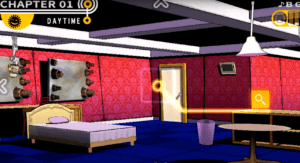
The player then traverses through various environments gathering clues and information, and once they’ve gathered all the necessary information, they proceed to the class trial. The class trial phase follows a somewhat similar loop, but instead of interaction through clicking, new insights and information are generated through 3 different forms of minigames – Nonstop Debate, a first-person shooter style minigame where you ‘shoot’ inconsistencies in people’s words with the correct evidence, Hangman’s Gambit, where you fill in words by matching floating letters, and the most loathsome of all, a literal multiple choice question.
Starting off with Nonstop Debate, I think it’s really cool! It’s this interesting combination of both a cognitive and physical challenge, where your understanding of the mystery is tested in a number of different ways – you have to be able to think on the fly to spot a contradictory statement, know which piece of evidence contradicts it, while also having the physical challenge of needing to react, aim, and shoot the contradictory statement.
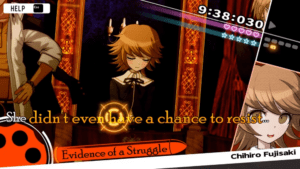
Also, there’s just a lot of charm and personality during these sections, such as unneeded statements from other characters appearing as physical obstructions preventing you from shooting an incorrect statement.
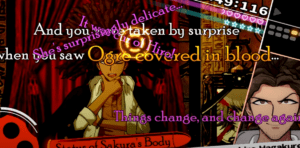
On the other hand, Hangman’s Gambit and the multiple choice questions are basically trivial – the questions are usually obvious and don’t contribute anything except for some arbitrary padding in between information reveals. Why do this to begin with if the answers are going to be obvious? How does playing this minigame contribute to the process of figuring out the mystery? They are essentially the same in function, and I don’t understand why these two mechanics exist at all – they honestly feel like insults to the player’s intelligence and ability to think critically through a mystery.
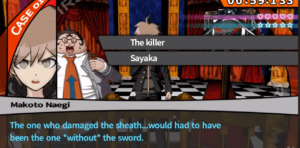
(Wow! What a breadth of options I’ve been given here!)
In general, both Danganronpa’s writing and its mechanics always seem to undermine the player’s intelligence and decision-making. During the investigation phase, the player is essentially forced to comb through each individual room and directly interact with each necessary piece of information regardless of whether or not you actually need it to piece together what’s going on. This often leads to annoying roadblocks where you’ll be spam clicking through a single room or running to every single room because you missed one small thing, unable to progress until you finally click on it, at which point you’ll usually be met with some pointless dialogue for something that you’ve already figured out on your own.
I understand that this limitation exists due to the fact that all the class trials are scripted and follow an exact logical path to the conclusion, but I would’ve liked if there were more ways to approach solving the mystery, maybe there were alternate paths or ways to reach conclusion more quickly if the player can form a conclusion with fewer pieces of evidence. This is compounded by some really strange writing choices where the characters will deliberate on a bunch of stuff that is so obvious it is borderline insulting – the primary piece of evidence in the first trial is literally the name of the killer written upside down in blood and instead of everyone figuring it out instantly, they all deliberate for 15 minutes going like “wow man I wonder what these weird symbols could mean this is crazy”. 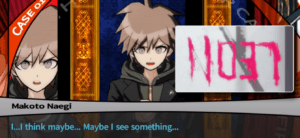
The overarching mystery of Danganronpa also isn’t helped by the gameplay much either. While the arc-based format of each chapter unlocking more of the campus grounds which lets the player explore and discover more, does have a satisfying progression to uncovering more of the mystery, it is incredibly unbalanced in how the player receives the information. Instead of being able to slowly uncover it through hints gathered across the game, 95% of the overarching mystery, which admittedly is quite interesting when revealed, is figured out in the last 10% of the game in a single investigation phase. There’s very little reward for the player to be extra curious or try and find out more about the overarching mystery, as outside the confines of the scripted discovery elements, there aren’t any hidden optional clues that might point to the truth that the player can go seek out on their own. Instead, hints are basically just randomly drip-fed to the player through the occasional dialogue or vague messages delivered by another character.
Anyway, the way this game handles its mysteries basically sucks but also I was really into it when I was 13 because of the edgy premise so it gets a pass.



